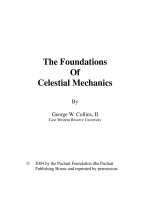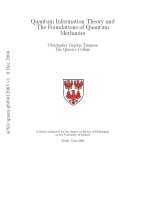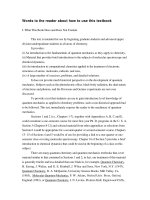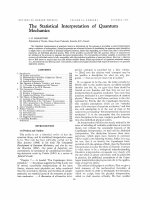- Trang chủ >>
- Khoa Học Tự Nhiên >>
- Vật lý
The interpretation of quantum mechanics
Bạn đang xem bản rút gọn của tài liệu. Xem và tải ngay bản đầy đủ của tài liệu tại đây (8.53 MB, 165 trang )
THE UNIV£RSITY OF WESTERN ONTARIO
SERIES IN PHILOSOPHY OF SCIENCE
A SERIES OF BOOKS
ON PHILOSOPHY OF SCIENCE, METHODOLOGY,
AND EPISTEMOLOGY
PUBLISHED IN CONNECTION WITH
THE UNIVERSITY OF WESTERN ONT ARlO
PHILOSOPHY OF SCIENCE PROGRAMME
Managing Editor
J. J. LEACH
Editorial Board
J. BUB, R. E. BUTTS, W. HARPER, J. HINTIKKA, D. J. HOCKNEY,
C. A. HOOKER, J. NICHOLAS, G. PEARCE
VOLUME 3
www.pdfgrip.com
JEFFREY BUB
University of Western Ontario, Ontario, Canada, and
Institute for the History and Philosophy of Science, Tel Aviv University, Israel
THE INTERPRETATION
OF QUANTUM MECHANIC
'.
D. REIDEL PUBLISHING COMPANY
DORDRECHT- HOLLAND / BOSTON- U. S. A.
www.pdfgrip.com
Library of Congress Catalog Card Number 74-76479
Cloth edition: ISBN 90 277 0465 1
Paperback edition: ISBN 90 277 0466 X
Published by D. Reidel Publishing Company,
P.O. Box 17, Dordrecht, Holland
Sold and distributed in the U.S.A., Canada, and Mexico
by D. Reidel Publishing Company, Inc.
306 Dartmouth Street, Boston,
Mass. 02116, U.S.A.
All Rights Reserved
Copyright © 1974 by D. Reidel Publishing Company, Dordrecht, Holland
No part of this book may be reproduced in any form, by print, photoprint, microfilm,
or any other means, without written permission from the publisher
Printed in The Netherlands by D. Reidel, Dordrecht
www.pdfgrip.com
TABLE OF CONTENTS
VII
PREFACE
I.
II.
III.
IV.
V.
VI.
VII.
VIII.
IX.
X.
XI.
XII.
The Statistical Algorithm of Quantum Mechanics
I. Remarks
II. Early Formulations
III. Hilbert Space
IV. The Statistical Algorithm
V. Generalization of the Statistical Algorithm
VI. Compatibility
The Problem of Completeness
I. The Classical Theory of Probability and Quantum
Mechanics
II. Uncertainty and Complementarity
III. Hidden Variables
Von Neumann's Completeness Proof
Lattice Theory: The Jauch and Piron Proof
The Imbedding Theorem of Kochen and Specker
The Bell-Wigner Locality Argument
Resolution of the Completeness Problem
The Logic of Events
I. Remarks
II. Classical Logic
III. Mechanics
Imbeddability and Validity
The Statistics of Non-Boolean Event Structures
The Measurement Problem
The Interpretation of Quantum Mechanics
1
1
3
8
15
24
28
32
32
36
46
49
55
65
72
84
92
92
93
105
108
119
128
142
BIBLIOGRAPHY
151
INDEX OF SUBJECTS
153
www.pdfgrip.com
www.pdfgrip.com
PREFACE
This book is a contribution to a problem in foundational studies, the
problem of the interpretation of quantum mechanics, in the sense of the
theoretical significance of the transition from classical to quantum
mechanics.
The obvious difference between classical and quantum mechanics is
that quantum mechanics is statistical and classical mechanics isn't.
Moreover, the statistical character of the quantum theory appears to be
irreducible: unlike classical statistical mechanics, the probabilities are
not generated by measures on a probability space, i.e. by distributions
over atomic events or classical states. But how can a theory of mechanics
be statistical and complete?
Answers to this question which originate with the Copenhagen interpretation of Bohr and Heisenberg appeal to the limited possibilities of
measurement at the microlevel. To put it crudely: Those little electrons,
protons, mesons, etc., are so tiny, and our fingers so clumsy, that whenever we poke an elementary particle to see which way it will jump, we
disturb the system radically - so radically, in fact, that a considerable
amount of information derived from previous measurements is no
longer applicable to the system. We might replace our fingers by finer
probes, but the finest possible probes are the elementary particles themselves, and it is argued that the difficulty really arises for these. Heisenberg's y-ray microscope, a thought experiment for measuring the position and momentum of an electron by a scattered photon, is designed to
show a reciprocal relationship between information inferrable from the
experiment concerning the position of the electron and information
concerning the momentum of the electron. Because of this necessary
information loss on measurement, it is suggested that we need a new kind
of mechanics for the microlevel, a mechanics dealing with the dispositions for microsystems to be disturbed in certain ways in situations
defined by macroscopic measuring instruments. A God's-eye view is
rejected as an operationally meaningless abstraction.
www.pdfgrip.com
VIII
THE INTERPRETATION OF QUANTUM MECHANICS
Now, it is not at all clear that the statistical relations of quantum
mechanics characterize a theory of this sort. After all, the genesis of
quantum mechanics had nothing whatsoever to do with a measurelnent
problem at the microlevel, but rather with purely theoretical problems
concerning the inadequacy of classical mechanics for the account of
radiation phenomena. Bohm and others have proposed that the quantum
theory is incomplete, in the sense that the statistical states of the theory
represent probability distributions over 'hidden' variables. Historically,
then, the controversy concerning the completeness of quantum mechanics has taken this form: A majority view for completeness, understood in
the sense of the disturbance theory of measurement, and a minority
view for incompleteness.
An interpretation of quantum mechanics should show in what fundamental respects the theory is related to preceding theories. I propose that
quantum mechanics is to be understood as a 'principle' theory, in Einstein's
sense of the term. The distinction here is between principle theories, which
introduce abstract structural constraints that events are held to satisfy
(e.g. classical thermodynamics), and constructive theories, which aim
to reduce a wide class of diverse systems to component systenls of a
particular kind (e.g. the molecular hypothesis of the kinetic theory of
gases). For Einstein, the special and general theories of relativity are
principle theories of space-time structure.
I see quantum mechanics as a principle theory of logical structure: the
type of structural constraint introduced concerns the way in which the
properties of a mechanical system can hang together. The propositional
structure of a system is represented by the algebra of idempotent magnitudes - characteristic functions on the phase space of the system in the
case of classical mechanics, projection operators on the Hilbert space of
the system in the case of quantum ·mechanics. Thus, the propositional
structure of a classical mechanical system is isomorphic to the Boolean
algebra of subsets of the phase space of the system, while the logical
structure of a quantum mechanical system is represented by the partial
Boolean algebra of subspaces of a Hilbert space. In general, this is a nonBoolean algebra that is not imbeddable in a Boolean algebra. As principle
theories, classical mechanics and quantum mechanics specify different
kinds of constraints on the possible events open to a physical system, i.e.
they define different possibility structures of events.
www.pdfgrip.com
PREFACE
IX
This view arises naturally from the Kochen and Specker theory of
partial Boolean algebras, which resolves the completeness problem by
properly characterizing the category of algebraic structures underlying
the statistical relations of the theory. Kochen and Specker show that it
is not in general possible to represent the statistical states of a quantum
mechanical system as measures on a classical probability space, in such a
way that the algebraic structure of the magnitudes of the system is preserved. Of course, the statistical states of a quantum mechanical system
can be represented by measures on a classical probability space if the
algebraic structure of the magnitudes is not preserved. But such a representation has no theoretical interest in itself in this context. The
variety of hidden variable theories which have been proposed all involve
some such representation, and are interesting only insofar as they introduce new ideas relevant to current theoretical problems. Invariably, the
reasons proposed for considering a new algebraic structure of a specific
kind are plausibility arguments derived from some metaphysical view of
the universe, or arguments which confuse the construction of a hidden
variable theory of this sort with a solution to the completeness problem.
I reject the Copenhagen disturbance theory of measurement and the
hidden variable approach, because they misconstrue the foundational
problem of interpretation by introducing extraneous considerations
which are completely unmotivated theoretically, and because they stem
from an inadequate theory of logical structure. With the solution of the
completeness problem, all problems in the way of a realist interpretation
of quantum mechanics disappear, and the measurement problem is
exposed as a pseudo-problem.
The short bibliography lists only works directly cited, and since the
sources of the ideas discussed will be obvious throughout, I have not
thought it necessary to introduce explicit references in the text, except in
the case of quotations.
www.pdfgrip.com
www.pdfgrip.com
CHAPTER I
THE STATISTICAL ALGORITHM OF
QUANTUM MECHANICS
I. REMARKS
Classical mechanics - Newton's general theory of motion developed and
articulated by Euler, Lagrange, and Hamilton - describes the temporal
evolution of a mechanical system in terms of the change in certain appropriate physical magnitudes (e.g. energy, angular momentum, etc.),
which are represented as real-valued functions on a 'phase space' X,
a linear (vector) space parametrized by generalized position and momentum coordinates, the phase variables.
For a free particle, the phase space is 6-dimensional, with position
coordinates ql, q 2' q3, representing the location of the particle in space,
and corresponding momentum coordinates Pl,P2,P3. The classical
mechanical equations of motion, Hamilton's equations:
dqi
oH
-=-
dt
0Pi
dpi
dt
oH
Oqi
-=--
(i = 1, 2, 3)
determine a trajectory in phase space, given the initial values of the
variables ql, Q2' Q3; Pl,P2,P3· The quantity H, the Hamiltonian, is a
function of the phase variables and characterizes the particular system
involved. Since the physical magnitudes are functions of the phase
variables, the values of these quantities are defined for every point on the
phase trajectory of the system, and are determined for all time via
Hamilton's equations by any point on the trajectory, i.e. by an assignment of values to the 'canonically conjugate' sets of phase variables
Ql, Q.2, Q3 andpl,P2,P3· Such an assignment of values - the specification
of a point X=(Ql,Q2,Q3;Pl,P2,P3) in phase space - is a classical
mechanical state.
Electromagnetic phenomena were incorporated into this scheme by the
Faraday-Maxwell theory of fields, a field being something like a mechanical system with a continuous infinity of phase variables. This extension
of classical mechanics began to collapse towards the end of the 19th
www.pdfgrip.com
2
THE INTERPRETATION OF QUANTUM MECHANICS
century. The quantum theory was conceived in 1900 with Max Planck's
solution to the 'ultra-violet catastrophe': Planck proposed that electromagnetic radiation is emitted and absorbed in discrete 'quanta', each
energy quantum being proportional to the frequency of the radiation.
The birth of quantum mechanics followed after a gestation period of
25 years, in the dual form of Schrodinger's wave mechanics and the
Heisenberg-Born-Jordan matrix mechanics. Schrodinger demonstrated
the equivalence of the two theories, and a unified 'transformation
theory' was developed by Dirac and Jordan on the basis of Born's
probabilistic interpretation of the wave function.
In Section II, I sketch the basic ideas behind matrix mechanics and
wave mechanics, presenting these theories as different algorithms for
generating the set of possible energy values of a system. I discuss von
Neumann's critique of the Dirac-Jordan transformation theory, and
show that matrix and wave mechanics are equivalent in the sense that
they represent formulations of a mechanical theory in terms of different
realizations of Hilbert space. The exposition in this section follows von
Neumann. My purpose is to show the origin of the Hilbert space formulation of quantum mechanics.
I develop the geometry of Hilbert space in Section III. I introduce the
notion of a Hilbert space as a vector space over the field of complex
numbers, with a scalar product which defines the metric in the space.
The core of this chapter is Section IV. Quantum mechanics incorporates
an algorithm for assigning probabilities to ranges of values of the physical
magnitudes. I introduce this algorithm in the elementary form applicable
to the finite-dimensional case. Essentially, probabilities are generated by
statistical states according to a certain rule. The 'pure' statistical states
are represented by the unit vectors in Hilbert space; the physical magnitudes are represented by operators· associated with orthogonal sets of
unit vectors, corresponding to the possible 'quantized' values of the
magnitudes. These orthogonal sets of unit vectors function like Cartesian
coordinate systems in a Euclidean space. The probability assigned by a
particular vector, t/I, to the value ai of the magnitude A is given by the
square of the projection of t/I onto the unit vector (Xi ('Cartesian axis')
corresponding to the value ai. The problem of 'degenerate' magnitudes magnitudes associated with m possible values and m orthogonal vectors
in an n-dimensional space (m
www.pdfgrip.com
STATISTICAL ALGORITHM OF QUANTUM MECHANICS
3
statistical algorithm, which is dealt with by the apparatus of projection
operators and subspaces. The infinite-dimensional case requires a
further generalization, in terms of the 'spectral measure' of an operator
representing a physical magnitude.
Finally, the possibility of statistical states representing 'mixtures' of
pure states involves a generalization in terms of the notion of the 'trace'
of an operator in Section V. This version of the statistical algorithm
represents the probability assigned by the statistical state W to the range
S of the magnitude A as the trace of the product WPA (S), where P A (S)
is defined by the spectral measure of the operator representing A for the
Borel set S.
Chapter I concludes with some remarks on the compatibility relation
defined on the set of magnitudes, corresponding to the commutativity of
the corresponding Hilbert space operators.
II. EARL Y FORMULA TIONS
Both matrix and wave mechanics propose algorithms for generating the
set of possible energy values of a system, and the transition probabilities
between the corresponding 'stationary states'. For simplicity, consider
a I-dimensional example, say a particle confined to one dimension of
space.
The method of matrix mechanics characterizes a quantum mechanical
system corresponding to a classical mechanical system with the Hamiltonian function H (q, p) by a Hamiltonian matrix H (Q, P), i.e. the classical phase variables q,p are associated with certain matrices Q, P, and the
classical Hamiltonian is associated with a corresponding Hamiltonian
matrix. A matrix is simply an element of a certain non-commutative
algebra, which can be represented by an array of (complex) numbers
with a finite or countable number of rows and columns. Different representations are possible for the same matrix. The matrices Q, Pare
required to satisfy the commutation relation
QP - PQ = ih/2n
where h is Planck's constant and i=j -1.
Under certain conditions, which we assume satisfied, there is a representation in which the numbers in the array representing H are all
www.pdfgrip.com
4
THE INTERPRETATION OF QUANTUM MECHANICS
zero, except along the diagonal, where they take real values. These are
the possible energy values of the system. (The position of a number in an
array representing a matrix is identified by the row number and column
number. By a diagonal element of a square matrix, I mean an element in
the position: row-i, column-i, for any i. The off-diagonal elements are
those in positions: row-i, column-j, i:/:. j.)
The arrays representing the matrices Q, P in this representation
determine the transition probabilities according to a certain rule. This
representation is found by solving the 'eigenvalue equation' for H:
"L..J H··e·=ee·
'J J
,
j
where Hij represents the element (complex number) in row-i and column-j
of the array in some arbitrary representation. The eigenvalue equation
will generally have a countable number of distinct solutions, i.e. there
will be a countable number of distinct 'eigenvalues'
and associated 'eigenvectors'
(ell), e~l), ... ), (el2 ), e~2), ... ), ...
which satisfy the equation, under the condition Lile~k)12 < 00, for each k
(where le~k) I denotes the absolute value of the complex number e~k»).
Here each eigenvector (elk), e~k), ... ) is a sequence of numbers, representing
the components of the kth eigenvector in the representation. The superscript (k) refers to the corresponding eigenvalue.
The diagonal representation of H is obtained as the product
S-lHS
where S is the matrix whose columns are the eigenvector solutions to the
eigenvalue equation for H. The elements along the diagonal in this representation are the eigenvalues, i.e. the eigenvalues of H are the possible
energy values of the system. Thus, the algorithm of matrix mechanics
reduces the problem of generating the set of possible energy values of a
system to the eigenvalue problem.
To sum up: The possible energy values of a system are obtained as the
diagonal values of the Hamiltonian matrix H of the system in a certain
privileged representation. H, expressed as an array of numbers with
www.pdfgrip.com
STATISTICAL ALGORITHM OF QUANTUM MECHANICS
5
respect to any given initial representation, is diagonalized - transformed
to this privileged representation - by a matrix S, constructed from the
eigenvector solutions to the eigenvalue equation in the initial represtion.
The matrices Q and P, transformed to the representation in which H
is diagonal by the transformation matrix S, determine the transition
probabilities between the stationary states corresponding the the different possible energy levels.
In the wave mechanical formulation, a quantum mechanical system
corresponding to a classical mechanical system with the Hamiltonian
function H (q, p) is characterized by a differential functional operator
H (q, - ih/2n(%q)) in 'configuration space', i.e. the space parametrized
by the position coordinates of the system. The possible energy values of
the system are those values of e for which the differential equation
H(q, - ih/2n :q) l/J(q) = el/J(q)
has solutions satisfying the condition J~ 00 Itfr(q)12 dq< 00. This is
Schrodinger's wave equation, an eigenvalue equation for the eigenvalues
e and corresponding (complex-valued) eigenfunctions 1/1. The eigenvalues e are the possible energy values, and the eigenfunctions represent the corresponding stationary states.
The Dirac-Jordan transformation theory exploits an apparent analogy
between the 'continuous' configuration space parametrized by the variable q in the case of the wave functions tfr(q), and the 'discrete' space
parametrized by the index i in the case of the sequences (81' 82, ... ),
regarded as functions 8(i) of the variable i. That is, a particular sequence
(81' 82 , ••• ) is regarded as a map 8 from a space of integers (1, 2, ... ) into
the complex numbers, and it is proposed that the equivalence of matrix
mechanics and wave mechanics has to do with some structural similarity
between this space and the space R of real numbers which the wave
functions map into the complex numbers. On this view, summation over
the 'discrete' variable i of the countable space corresponds to integration
over the 'continuous' variable q of the uncountable space, and so the
eigenvalue equation of matrix mechanics
www.pdfgrip.com
www.pdfgrip.com
www.pdfgrip.com
www.pdfgrip.com
www.pdfgrip.com
www.pdfgrip.com
www.pdfgrip.com
www.pdfgrip.com
www.pdfgrip.com
www.pdfgrip.com
www.pdfgrip.com




![Some novel thought experiments foundations of quantum mechanics [thesis] o akhavan](https://media.store123doc.com/images/document/14/rc/oh/medium_ohb1395042255.jpg)




